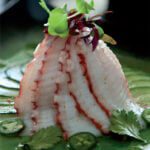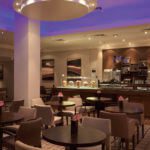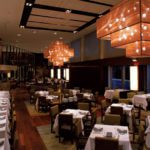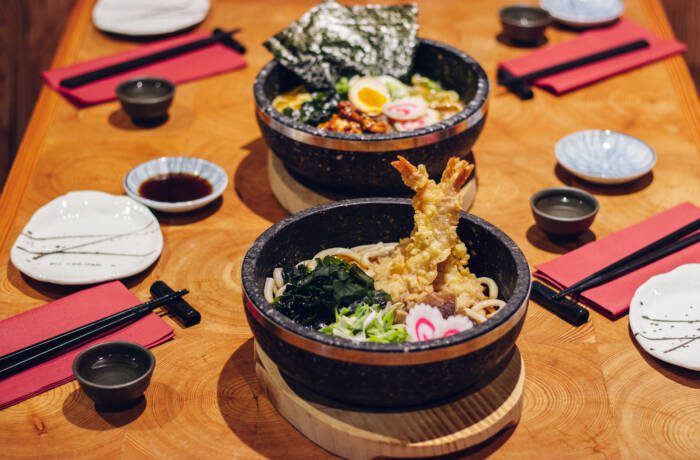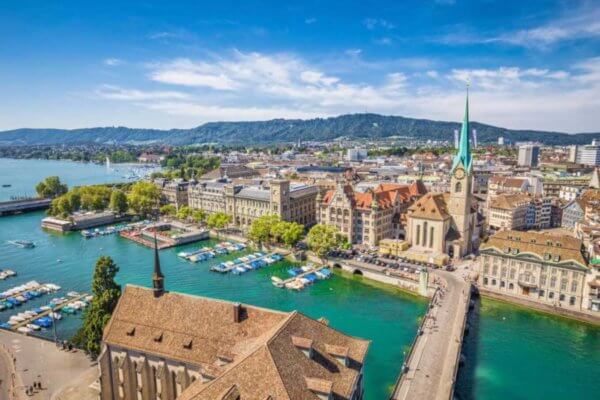- Blade Roll, one of the specialty rolls of Blade, Miami
- The Chateau building of the Fountainebleau, Miami
- Octopus carpaccio at Blade
- Recently reopened Villandry in London’s NoHo
- Villandry combines the best elements of food shop, restaurant and café
- Executive Lounge at the Hilton, Glasgow
- The stunning 15th hole at Cameron House
- The Parkhuus restaurant at the Park Hyatt, Zurich
DARIUS SANAI’S Luxury travel views Where our Editor-in-Chief ponders culinary conundrums from his sojourns around the world
Not so long ago, to experience the best of the world’s cuisine, you had to travel to their origins. Interested in exploring Escoffier’s legacy? Fly to Paris, Burgundy or Lyon. Want to know what the greatest sashimi tastes like? Try the stalls at Tsukiji Market in Tokyo. To taste the best Shanghainese seafood, you’d need to be looking at the Yellow River.
Now, everything has changed. Now there’s no question about being inauthentic if you taste Tuscan food in Vegas, or sample Joel Rebouchon in London, or Nobu in, well, anywhere. The greatest ingredients, and the greatest chefs, are where they are.
Which makes Miami such an interesting conundrum. The only food the city can really, authentically claim as its own is Cuban, imported by the hordes fleeing Fidel Castro from the 1960s onwards. That, and the ubiquitous stone crab, served by the pile, a food to eat with fries and a big Sonoma Chardonnay and to grow fat on.
But Miami is also South Beach, host of America’s biggest annual food festival, home to some of the most glamorous restaurants and hotels in America outside Vegas; the place where Russian oligarchs and New York tycoons gather under the sun to talk art, women, wine and song on megayachts and in megaresidences.
And I was intrigued by what my megahotel in SoBe, the Fountainebleau, would have to offer. On the culinary side, that is. As a resort hotel, its offering is pretty evident to anyone arriving up its driveway crowded with limos and Lambos: about 10,000 rooms in various buildings, Art Deco and mock; a properly mega swimming pool which I estimated as around 60m curved end to end, which would have been perfect for lengths, had it not been overoccupied by smooching couples taking advantage of its uniform shallowness; a private shopping mall; a stretch of private beach with uniformed staff shifting sunloungers to the evermoving gaps in the afternoon sunlight as the sun set beneath the giant structures of the hotel itself.
The Fountainebleau is not short of celebrated options, with Hakkasan and Scarpetta operating there. Just to be different I chose to entertain my guests at the hotel’s nouveau-Japanese restaurant Blade, which registers there as one of the ‘casual’ dining options. ‘Casual’ meaning informal service and a lack of tablecloths, rather than low prices.
It was eye-opening. The straight sashimi and nigiri – yellowtail, sea bream toro – was as good as sashimi can be, flown in from Tsukiji as it is in any fine sushi restaurant. A mark of standards and craft, but nothing else.
It was the speciality rolls that would make or break Blade. These were ambitious: the Geisha, with yellowtail, ooba leaf, orange, asparagus wrapped in soy paper with a yuzu miso glaze. The Chateau with spicy snow crab, spring onions, cucumbers, and spicy tuna. The Dragon, with deep-fried shrimp, asparagus, avocado, barbecue eel, miso wasabi and aioli. And what about the Ronin: salmon, mozzarella, tomato, cilantro, Serrano ham, chilli, and crispy onion – about as derivative as you can get and still claim Japanese roots, sort of.
We tried all these rolls and more, and my conclusion on Blade reflects the conclusion on cuisine in general, which in turn reflects a contemporary worldview. They were on the whole beautifully made, with ingredients that had plainly been sourced from the very best possible sources, and hewn together by a chef who understood the intricacies of the human palate. I entertained at Blade every time I could during my sojurn; even ate there by myself once.
But the fact that I was eating at a soi-disant Japanese in a corner of the United States was irrelevant: this is the new food, inspired by everywhere, with certain splashes of somewhere more prominent than others, meticulously made, perfectly served. Just as the model in the corner was a mix of Chinese, Persian, Russian and German, from everywhere and nowhere, so was Blade’s food. Once that meant the worst: international cuisine. Now it is the trademark of a new contemporary quality.
Many hotels thrive these days by attaching luxury brand chefs’ names to their restaurants: these bring in visitors who otherwise would not be seen dining at a hotel restaurant, for fear of appearing like tourists. One of my favourite hotels in the world, though, has another take. The Parkhuus restaurant, in the Park Hyatt Zurich, is as cool, and spectacular in its internal architecture, and as imaginative in its menu, as any high-concept chef ’s: but the restaurant is entirely the hotel’s own.
A sweeping open kitchen dominates the room; ceilings are high, as are windows; tables lack formal dressing, instead bedecked in contemporary architecture. The menu effortlessly combines the casual and the formal, the haute and the bas: you can simply choose ‘Chop, Wood Roasted, 400g’; or go for the Swiss ‘pike-perch fillet, pan fried, herb crust, herb salad, tomato jam’ accompanied by the wood-roasted seasonal vegetables. Both were sublime in their delicacy with the signature of the Parkhuus wood oven.
The menu at Parkhuus is brutally seasonal, in the best possible way: there are no signature dishes, only seasonal dishes, so if you go in autumn you would be crazy not to try the products of shoots in nearby Burgundy, for example. As befits one of the very best restaurants in the city that serves as the capital of Europe’s wealth management business, the wine cellar is breathtaking in its breadth, although I have recently favoured the local draft beer, served swiftly and ice-cool, its hoppy bitterness a welcome counterpoint to the slight caramel sweetness that arises in some of the woodroast dishes.
Parkhuus is an interesting room in that it runs counter to what I normally admire about restaurants. It is a big space, with big windows, and a view technically of nothing but the other side of a quiet Zurich street. Yet it feels sexy, alive, because of the lighting, the attitude, the décor, the service, the style. You feel this is a destination for locals, not because of the name of a chef above the door, but because of the sheer quality.
Around 1000 miles north of Zurich, on a very different kind of lake, is the Scottish Highland hotel of Cameron House. Cameron House is on Loch Lomond, a long lake that stretches like a finger into the Highlands, and you can’t quite imagine the barren beauty that unfolds before you as you stand on the lochside of the hotel, without having been there. On one of Scotland’s most famous lochs, this is the perfect location.
The hotel’s main restaurant has fine views over the water, but on my latest visit I stopped in on the Boat House, the more casual option, on the water’s edge. You feel as though you are floating on this untamed loch, and the casual atmosphere is enhanced by the engagingly informal staff – and the crowds, for this is a popular place.
The menu is created by the Loch Fyne people, they of seafood bars across the UK, and that guaranteed a level of quality: excellent selection of salmon of various smokes, mussels that were well cooked in white wine and parsley; spectacularly presented oysters. Good quality for a seafood lover, if nothing too ambitious, but the view of a snowstorm whitening the head of Ben Lomond across the water (this can happen at any time of year) was ambitious enough.
In the course of my annual travels I stay in quite a number of luxury hotels, and those that disappoint usually outnumber those that excel. So it is a delight when a hotel that was supposed to do nothing other than perform solidly, does so with flair and a panache of proper hotellerie, like a mid-division football team suddenly matching Barcelona at their own game.
That was my experience, shortly after Cameron House, with the Hilton Central in Glasgow. Hilton has been demeaned as a brand over the past years, the sometimes glorious towers of Hilton International now replaced by business lodges stamped with the brand. Some exceptions remain, for me in the U.S., and London’s Park Lane: but Glasgow’s Hilton is evidently in a category of its own. The service was not only attentive but intuitive; the rooms well-arranged, a sort of cookiecutter- plus, for road warriors who want to know where everything is but also have high standards. It was the food that surprised, a sequence of room services arriving swiftly and with pride, steaming hot, sea bass cooked a point, a perfectly herbed soup: the kinds of things you wish room service would do around the world, but it so rarely does. And with staff that took pride: they were neither overtrained, nor obsequious, nor over-aware, nor over-cool: just spot on. Hilton Glasgow, you outdo many of your more glamorous five-star rivals.
Back very much closer to home, I am delighted at the reopening, after a few months’ refurbishment, of my favourite part of one of my favourite restaurant/food shops, Villandry, in London’s NoHo. Villandry is part café, part food hall, part restaurant, and the latter two have just reopened, accompanied by a fine wine theme and a bank of those fine Enomatic machines at which you can taste fine wine by the small pour. Redecorated in exquisite taste by Claire Sheppard and her team, it retains that light, airiness so rare in central London venues, as well as fine ingredients cooked simply, whether for breakfast, lunch or a prix-fixe dinner. Bon appétit.
Darius Sanai is Editor-in-Chief of Condé Nast Contract Publishing



